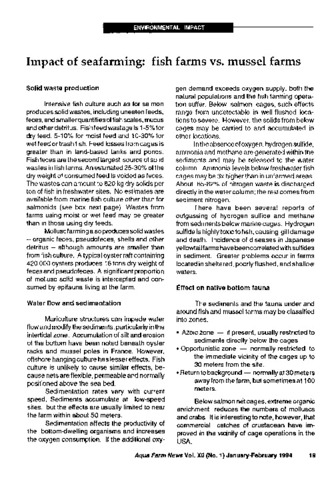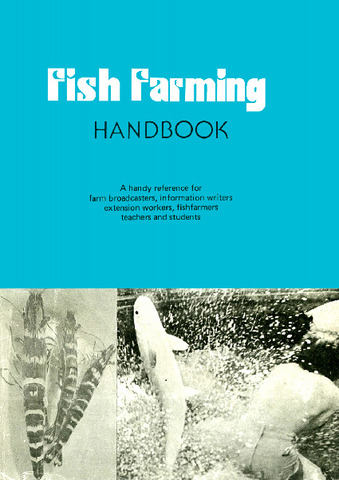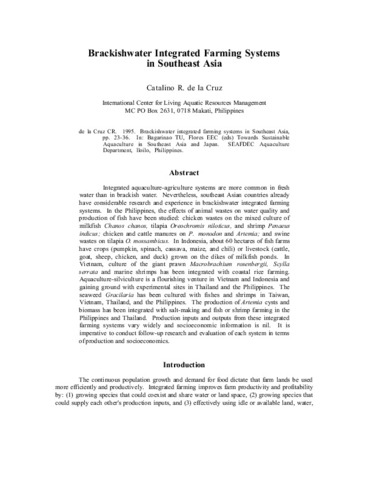| dc.contributor.author | Tendencia, Eleonor | |
| dc.contributor.author | Bosma, Roel H. | |
| dc.contributor.author | Verreth, Johan A. J. | |
| dc.date.accessioned | 2014-06-23T06:40:55Z | |
| dc.date.available | 2014-06-23T06:40:55Z | |
| dc.date.issued | 2011 | |
| dc.identifier.citation | Tendencia, E. A., Bosma, R. H., & Verreth, J. A. J. (2011). White spot syndrome virus (WSSV) risk factors associated with shrimp farming practices in polyculture and monoculture farms in the Philippines. Aquaculture, 311(1-4), 87-93. | en |
| dc.identifier.issn | 0044-8486 | |
| dc.identifier.uri | http://hdl.handle.net/10862/2120 | |
| dc.description.abstract | White spot sydrome virus (WSSV) is one of the most important viral disease of shrimp. Several studies to control the disease have been done. Tank experiments identified WSSV risk factors related to the physico chemical properties of the water. A few studies reported pond level WSSV risk factors. This study identifies the risk factors associated with essentially two different farming systems: polyculture and semi-intensive monoculture of Penaeus monodon. Data were gathered from a total of 174 shrimp farmers in eight provinces of the Philippines using a structured questionnaire. Forty-seven variables related to pond history and site description, period of culture, pond preparation techniques, water management, culture methods, feed and other inputs, and biosecurity measures were investigated. In the analysis for combined monoculture and polyculture farms, feeding live molluscs was identified as important WSSV risk factors. In addition to feeding live molluscs, sharing of water source with other farms, having the same receiving and water source, larger pond size, and higher stocking density were identified as important WSSV risk factors in monoculture farms. Climate, i.e. stocking during the cold months and sludge removal and its deposition on the dikes were identified as WSSV risk factors in polyculture farms. Protective factors, listed in decreasing significance, were feeding with planktons and high mangrove to pond area ratio, both observed in the dataset with both monoculture and polyculture farms, while only the latter was observed in the dataset for monoculture farms only. No protective factor was observed in the dataset for polyculture farms.
This study confirmed the negative effect of sharing water source with other farms and identified several new factors influencing WSSV infection such as feeding live molluscs increases the risk, while feeding with planktons and high mangrove to pond area ratio reduce the risk. | en |
| dc.description.sponsorship | The authors wish to acknowledge the funding support of the Government of Japan under the trust fund granted to SEAFDEC AQD (study code: GoJ TFD FH0206) and RESCOPAR, Wageningen University, the Netherlands. Our gratitude also goes to those who supported and assisted in the conduct of the survey−Dr. John Albaladejo and staff: Ruel, Pepe, and Wetet; Mr. Andres Bojos and staff: Carol, Tetet, Joy, Jonah, Renren and Nong Nards; Dr. Gigi Carillo and staff: Ron, Mel, Johnel, Elsie, Bart, and Guada; Bong and Roselyn; Mr. Rey Cawaling, and Ms. Sarah Fedelicio; and to the shrimp farmers of Aklan, Antique, Bohol, Bulacan, Cebu, Leyte, Negros and Northern Samar who willingly and unselfishly shared their experiences. | en |
| dc.language.iso | en | en |
| dc.publisher | Elsevier | en |
| dc.subject | Mollusca | en |
| dc.subject | Penaeus monodon | en |
| dc.subject | Philippines | en |
| dc.subject | farm management | en |
| dc.subject | risk factors | en |
| dc.title | White spot syndrome virus (WSSV) risk factors associated with shrimp farming practices in polyculture and monoculture farms in the Philippines | en |
| dc.type | Article | en |
| dc.citation.volume | 311 | |
| dc.citation.issue | 1-4 | |
| dc.citation.spage | 87 | |
| dc.citation.epage | 93 | |
| dc.citation.journalTitle | Aquaculture | en |
| dc.subject.asfa | mangroves | en |
| dc.subject.asfa | marine molluscs | en |
| dc.subject.asfa | monoculture | en |
| dc.subject.asfa | White spot syndrome virus | en |
| dc.subject.asfa | plankton surveys | en |
| dc.subject.asfa | polyculture (aquaculture) | en |
| dc.subject.asfa | pond culture | en |
| dc.subject.asfa | ponds | en |
| dc.subject.asfa | shellfish culture | en |
| dc.subject.asfa | shrimp culture | en |
| dc.identifier.doi | 10.1016/j.aquaculture.2010.11.039 | |
| dc.subject.scientificName | Penaeus monodon | en |



